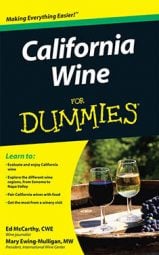Canada’s wines are known mainly to Canadians, who consume the bulk of their country’s production. Ask many wine lovers in the U.S. about Canadian wines, and you’ll probably get a blank stare in response.
The 1990s brought incredible growth to the Canadian wine industry: The number of wineries grew from 30 to over 400 today. Wine is made in four of Canada’s provinces, but Ontario has bragging rights as the largest producer, with over 100 wineries. British Columbia ranks second. Quebec and Nova Scotia also produce wine.
To identify and promote wines made entirely from local grapes (some Canadian wineries import wines from other countries to blend with local production), the provinces of Ontario and British Columbia have established an appellation system called VQA, Vintners’ Quality Alliance. This system regulates the use of provincial names on wine labels, establishes which grape varieties can be used, and requires wines to pass a taste and laboratory test.
Ontario vineyards
Ontario’s vineyards are cool-climate wine zones, despite the fact that they lie on the same parallel as Chianti Classico and Rioja, warmer European wine regions. Sixty percent of the production is white wine, from Chardonnay, Riesling, Gewürztraminer, Pinot Blanc, Auxerrois, and the hybrids Seyval Blanc and Vidal. Red wines come from Pinot Noir, Gamay, Cabernet Sauvignon, Cabernet Franc, Merlot, and the hybrids Maréchal Foch and Baco Noir.
Ontario’s VQA rules permit the use of the appellation Ontario and also recognize three Designated Viticultural Areas (DVAs), listed in order of importance:
Niagara Peninsula: Along the south shore of Lake Ontario
Pelee Island: Eleven miles south of the Canadian mainland, in Lake Erie, Canada’s most southerly vineyards
Lake Erie North Shore: The warmest of Ontario’s viticultural areas
Because winter temperatures regularly drop well below freezing, icewine, made from grapes naturally frozen on the vine, is a specialty of Ontario. It is gradually earning the Canadian wine industry international attention, particularly for the wines of Inniskillin Winery. VQA regulations are particularly strict regarding icewine production, as it has developed into the leader of the Canadian wine exports.
British Columbia vineyards
The rapidly growing wine industry of British Columbia now boasts more than 70 wineries. Production is mainly white wine — from Chardonnay, Gewürztraminer, Pinot Gris, Pinot Blanc, and Riesling — but red wine production is increasing, mainly from Pinot Noir and Merlot.
The Okanagan Valley in southeast British Columbia, where the climate is influenced by Lake Okanagan, is the center of wine production; Mission Hill is a leading winery. VQA rules recognize five Designated Viticultural Areas, listed in order of importance:
Okanagan Valley
Similkameen Valley
Fraser Valley
Vancouver Island
Gulf Islands

